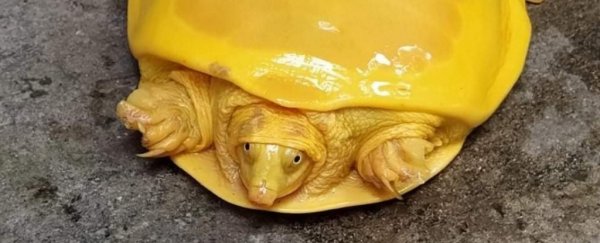For the second time in just three months the Indian Forest Service has announced the discovery of a golden flapshell turtle.
Like a slice of cheese, a slab of butter, or the yolk of an egg, this zesty creature with its vivid yellow shell, head, and limbs looks good enough to eat - and has fast become an internet sensation.
Today a Yellow Turtle was rescued from a Pond in Burdwan,WB. It's one kind of a rarely occuring Flapshell Turtle. @ParveenKaswan @SanthoshaGubbi @RandeepHooda @rameshpandeyifs pic.twitter.com/enTyNAkxmP
— Debashish Sharma, IFS (@deva_iitkgp) October 27, 2020
While such aberrations of colour are rare in nature, this bizarre phenomenon is more common than many recognise.
Yellow variants of the Indian flapshell turtle (Lissemys punctata) - which typically are brown with yellow spots and a creamy white underside - have been discovered a handful of times over the years in various parts of South Asia, where it is one of the most common aquatic turtle species.
The genetic anomaly doesn't happen often, but when it does, it tends to stand out.
In 1997, a turtle with a uniformly yellow body and pink eyes was discovered in Gujarat on the west coast of India, and other similar examples are said to have been found in Myanmar and Bangladesh, although the data are unpublished.
Just this summer, a golden turtle was snapped in Odisha, an eastern Indian state, and when posted on Twitter, a wildlife biologist in India claimed to have found three such individuals the year before.
Even more recently, a paper was published on the first discovery of a golden flapshell found in Nepal.
A rare yellow turtle was spotted & rescued in Balasore, Odisha yesterday.
— Susanta Nanda (@susantananda3) July 20, 2020
Most probably it was an albino. One such aberration was recorded by locals in Sindh few years back. pic.twitter.com/ZHAN8bVccU
While there's little information on the most recent finds, the phenomenon is thought to be caused by a lack of body pigmentation.
It's similar to pure albinism - a genetic disorder that causes a complete lack of pigments in the body - but instead of showing up completely white, in certain cases, yellow pteridine pigments can survive to dominate colour production (along with eye pigments).
This is known as chromatic leucism, and among turtles, researchers say it can produce the most "dazzling" colour variants.
While not exactly rare among flapshell turtles, researchers describe the phenomenon as "relatively uncommon".
In July, when the first golden turtle of the year went viral, herpetologists in India explained that in some cases, if a different pigment makes it through, this species can even appear red. That said, examples of such ruby-coloured turtles are almost impossible to find online.
But while turtles sporting such vivid hues might be cherished as viral phenomena and could be highly prised in the pet trade, in nature lacking your normal colouration can be quite the burden.
"For instance, a normally coloured L. punctata is much better camouflaged in the murky, greenish, aqueous environment the species frequents than a gold-coloured individual," explains the paper written on the Nepal discovery.
Very often, these golden creatures are 'rescued' from their natural habitats and relocated to new areas or placed in captivity.
In this new case, the golden turtle was accidentally snared in a fishing net, and as herpetologist Sneha Dharwadkar explains on Twitter, this represents a problem.
"Its almost impossible to relocate flapshells anywhere because 1. they are found in most waterbodies…" she writes, "2. Most places have fishing."
"[W]e need to find an alternative to relocating flapshells," she adds.
It's not easy being green, but apparently it's a lot harder being yellow.
